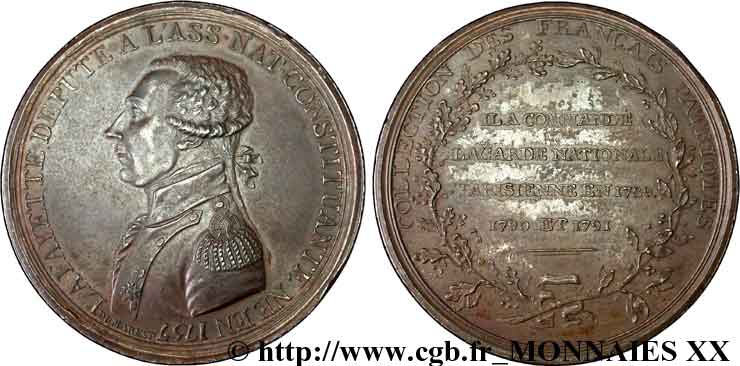v20_0720 - LAFAYETTE (MARIE-JOSEPH-PAUL-ROCH-YVES-GILBERT MOTIER, MARQUIS OF) Médaille de LaFayette
MONNAIES 20 (2004)
Starting price : 200.00 €
Estimate : 300.00 €
Realised price : 200.00 €
Number of bids : 1
Maximum bid : 310.00 €
Starting price : 200.00 €
Estimate : 300.00 €
Realised price : 200.00 €
Number of bids : 1
Maximum bid : 310.00 €
Type : Médaille de LaFayette
Date: (1791)
Date: n.d.
Metal : copper
Diameter : 35 mm
Orientation dies : 6 h.
Engraver Rambert Dumarest
Weight : 20,32 g.
Edge : SE. VEND. A. PARIS. CHEZ. MONNERON (PATENTE’)
Rarity : R1
Coments on the condition:
Exemplaire frappé sur un flan large et régulier. Une jolie patine marron le recouvre
Catalogue references :
Obverse
Obverse legend : LAFAYETTE DEPUTE A L’ASS. NAT. CONSTITUANTE NE EN 1757 / DUMAREST.
Obverse description : Buste de Lafayette en uniforme à gauche.
Obverse translation : (Lafayette, députe de l’Assemblée Nationale Constituante, né en 1757).
Reverse
Reverse legend : COLLECTION DES FRANÇAIS PATRIOTES / IL A COMMANDÉ / LA GARDE NATIONALE / PARISIENNE EN 1789. / 1790 ET 1791 / (DEUX TRAITS.
Reverse description : ).
Commentary
Il existe plusieurs variétés de cette médaille, avec tranche inscrite et lisse. D’après Hennin, p. 196, “La suite de médailles indiquée sur le revers, sous le nom de Collection des Français patriotes, n’a pas été continuée ; cette pièce est la seule qui porte cette indication. Elle a été gravée par Ramberg Dumarest. Il y a six variétés de cette pièce ; les cinq autres sont décrites aux numéros suivans. Ce grand nombre de variétés de la même médaille prouve qu’elle fut très multipliée, et combien était grande alors la popularité dont jouissait M. de La Fayette”.








 Report a mistake
Report a mistake Print the page
Print the page Share my selection
Share my selection Ask a question
Ask a question Consign / sell
Consign / sell